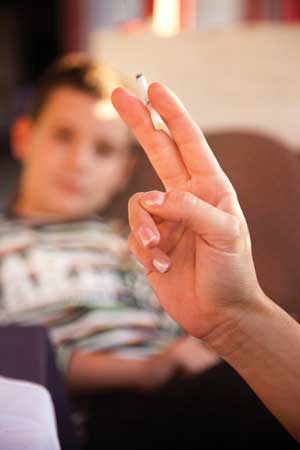Reducing Preventable Problems of Second-hand Smoke
by Teddi Fine
Smoking is more than an environmental pollutant: it is the foremost cause of lung cancer and a contributor to chronic pulmonary diseases. The second-hand effects of smoking extend to everyone who shares a smoker’s environment, compromising health and aggravating pre-existing breathing problems like allergies and sinus difficulties or more serious illnesses like asthma and cystic fibrosis. The safety and public health effects of smoking explain why it has been banned by law in many public places, including municipal buildings, restaurants, workplaces, public parks, and other gathering places across the country.
 But people remain free to light up in their own home—the private spaces in which young children live, play, and sleep. As a result, as many as 30% of U.S. children are exposed to second-hand smoke where they live. Among inner-city children with asthma, that figure can rise to as high as 67%, increasing their risk for exacerbations, trips to the emergency room or doctor, and the need for anti-inflammatory asthma medications. The result can be lost days at school, lost family income, and higher healthcare costs.
But people remain free to light up in their own home—the private spaces in which young children live, play, and sleep. As a result, as many as 30% of U.S. children are exposed to second-hand smoke where they live. Among inner-city children with asthma, that figure can rise to as high as 67%, increasing their risk for exacerbations, trips to the emergency room or doctor, and the need for anti-inflammatory asthma medications. The result can be lost days at school, lost family income, and higher healthcare costs.
In lieu of smoking cessation at home, what, if anything, can be done to reduce these preventable problems for asthmatic children? In a six-month, randomized, controlled study of asthmatic children living with smokers, School of Nursing professor and School of Medicine faculty member Arlene Butz, ScD, CPNP, and others found that regular use of indoor air cleaners can greatly reduce household air pollution and lower rates of children’s daytime asthma symptoms. [“A Randomized Trial of Air Cleaners and a Health Coach to Improve Indoor Air Quality for Inner-City Children with Asthma and Second-hand Smoke Exposure,” Archives of Pediatrics and Adolescent Medicine, August 2011]
However, while improving overall air quality in homes, the air cleaners neither reduced air nicotine levels nor cotinine levels, a biomarker of second-hand smoke, in these children. “Air cleaners are a temporary tool on the road to smoking cessation, not a replacement for a smoke-free home,” notes Butz. “As nurses, we recognize that while total home smoking bans are hard for inner-city families to sustain, such bans are good for the public health and for child and family health, too.”